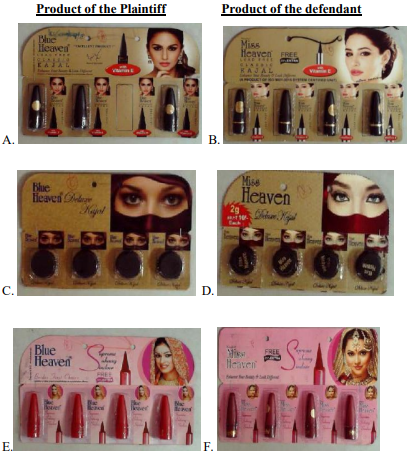K.R. Chinna Krishna Chettiar Vs. Shri Ambal and Co., Madras and Anr.
K.R. Chinna Krishna Chettiar Vs. Shri Ambal and Co., Madras and Anr.
Full Bench Decision
(1969) 2 SCC 131
The parties were manufacturers of snuff carrying on business at Madras. Both had their business in and outside of Madras. Respondents were the proprietors of the registered mark consisting of a label containing a device of a goddess Sri Ambal seated on a globe floating on water enclosed in a circular frame with the legend ‘Sri Ambal parimala snuff’ at the top of the label, and the name and address ‘Sri Ambal & Co., Madras’ at the bottom. The Respondents were in the snuff business for more than five decades.
The mark of which the Appellant sought registration consisted of a label containing three panels. The first and the third panels containeed in Tamil, Devanagri, Telugu and Kannada the equivalents of the words ‘Sri Andal Madras Snuff’. The center panel contains the picture of goddess SriAndal and the legend “Sri Andal”. Sri Andal and Sri Ambal were separate divinities.
The Respondents opposed the Registration of the Appellant’s Mark. The Registrar granted registration to the Appellant’s mark by holding that “the sound of ‘Ambal’ does not so nearly resemble the sound of ‘Andal’, in spite of certain letters being common to both the marks, as to be likely to cause confusion or deception among a substantial number of persons.”
An appeal was filed in the Madras High Court, which reversed the decision of the Registrar finding phonetic similarity between the Appellant’s mark and Respondent’s mark. Appellant filed the appeal before the Divisional Bench of the High Court. The Division Bench dismissed the appeal. The Respondents filed a special leave petition before the Supreme Court of India.
The Supreme Court observed:
• There can be no doubt that the word “Ambal” is an essential feature of the trade marks.
• If the proposed mark is used in a normal and fair manner the mark would come to be known by its distinguishing feature “Andal”..
• There is no evidence of actual confusion, but that might be due to the fact that the Appellant’s trade is not of long standing.
• There is no visual resemblance between the two marks, but ocular comparison is not always the decisive test.
• The resemblance between the two marks must be considered with reference to the ear as well as the eye.
• There is a close affinity of sound between Ambal and Andal.
• The name Andal does not cease to be deceptively similar because it is used in conjunction with a pictorial device.
Defendant’s Contention: The marks have different meanings
Supreme Court’s Observations:
“The Hindus in the south of India may be well aware that the words Ambal and Andal represent the names of two distinct goddesses. But the respondent’s customers are not confined to Hindus alone. Many of their customers are Christians, Parsees, Muslims and persons of other religious denominations. Moreover, their business is not confined to south of India. The customers who are not Hindus or who do not belong to the south of India may not know the difference between the words Andal and Ambal. The words have no direct reference to the character and quality of snuff. The customers who use the respondent’s goods will have a recollection that they are known by the word Ambal. They may also have a vague recollection of the portrait of a benign goddess used in connection with the mark. They are not likely to remember the fine distinctions between a Vaishnavite goddess and a Shivaite deity.”
The Appeal was dismissed with costs.



